Today’s Current Affairs: 20th November 2024 for UPSC IAS exams, State PSC exams, SSC CGL, State SSC, RRB, Railways, Banking Exam & IBPS, etc
Table of Contents
Genus Koima : New Genus Of Freshwater Fish
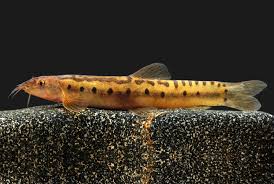
A team of researchers have discovered Koima, a new genus of freshwater fish endemic to the Western Ghats.
- The generic name, Koima is derived from Malayalam and is the vernacular word used for loaches.
- It encompasses two known species that were previously assigned under the genus Nemacheilus.
- It has a unique colour pattern comprising a yellowish-brown ground colour, single row of black spots on lateral line, all fins hyaline, and absence of a uniform banding pattern on dorsal side.
- Habitat: Kunthi, Bhavani, Moyar, Kabini, and Pambar rivers in the Western Ghats.
Guru Ghasidas-Tamor Pingla Tiger Reserve : New Tiger Reserve

Union Minister for Environment, Forest and Climate Change informed the Nation about the notification of the Guru Ghasidas-Tamor Pingla Tiger Reserve, Chhattisgarh, as the 56th Tiger Reserve of the country.
- Guru Ghasidas-Tamor Pingla Tiger Reserve is located in the northern part of the state Chhattisgarh, bordering Madhya Pradesh and Jharkhand.
- It is the third largest tiger reserve in the country after Nagarjunasagar-Srisailam Tiger Reserve in Andhra Pradesh and Manas Tiger Reserve in Assam.
- This tiger reserve is connected to the Bandhavgarh Tiger Reserve in Madhya Pradesh to the West and Palamau Tiger Reserve in Jharkhand to the East.
- It is nestled in the Chota Nagpur plateau and partly in Baghelkhand plateau.
- It is contiguous with the Sanjay Dubri Tiger Reserve in Madhya Pradesh.
- It serves as the origin of significant rivers such as Hasdeo Gopad and Baranga and a catchment area for rivers like Neur, Bijadhur, Banas, Rehand, and numerous smaller rivers and rivulets.
- It is blessed with varied terrains, dense forests, streams and rivers favourable for harbouring a rich faunal diversity and contains critical habitats for the tiger.
Grievance Redressal Assessment And Index:
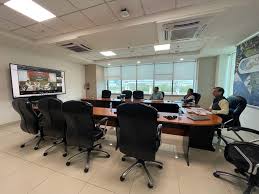
The Union Minister of State (Independent Charge) Science & Technology has launched Grievance Redressal Assessment and Index (GRAI) 2023.
- Grievance Redressal Assessment And Index was conceptualized and designed by the Department of Administrative Reforms and Public Grievances (DARPG), Government of India based on the recommendation of Parliamentary Standing Committee of Ministry of Personnel, Public Grievances and Pensions.
- It has an objective to present organization-wise comparative picture and provide valuable insights about strengths and areas of improvement regarding grievance redressal mechanism.
- The first edition of GRAI 2022 was released on 21 June 2023.
- Eighty-nine Central Ministries and Departments were assessed and ranked based on a comprehensive index in the dimensions of (1) Efficiency, (2) Feedback, (3) Domain and (4) Organisational Commitment and corresponding 11 indicators.
- To compute the index, data between January and December 2023 was used from the Centralised Public Grievance Redressal and Management System (CPGRAMS).
- Department of Agriculture and Farmers Welfare, O/o the Comptroller & Auditor General of India and Department of Investment & Public Asset Management have topped the rankings in Group A, B and C respectively.
- This report presents a two-dimensional (vertical and horizontal) analysis of the root causes of effective redressal of grievances of each Ministries and Departments in an easily discernible colour coded analysis.
- The report also presents a brief description of technical partners DARPG has engaged to facilitate the Ministries and Departments to optimally utilize CPGRAMS as a means of effective grievance redressal media.
- This report presents a clear roadmap with an advisory for the Ministries and Departments to leverage CPGRAMS and its features like IGMS 2.0, TreeDashboard, etc., to enhance grievance redressal.
- The roadmap for improvement emphasizes integrating advanced technologies like AI and ML for data analysis, predictive analytics and preventive measures while revising ATR formats for better reporting.
- Capacity building for GROs, enhancing accountability through audits and extending CPGRAMS integration to th
One Day One Genome Initiative:
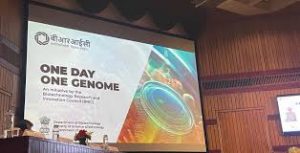
The Department of Biotechnology (DBT) and Biotechnology Research and Innovation Council (BRIC) introduced the ‘One Day One Genome’ initiative to showcase the enormous microbial potential of India.
- One Day One Genome Initiative will highlight the unique bacterial species found in our country and emphasize their critical roles in environment, agriculture and human health.
- This initiative is coordinated by Biotechnology Research and Innovation Council-National Institute of Biomedical Genomics (BRIC-NIBMG) an institute of the Department of Biotechnology.
- This initiative aims to release a fully annotated bacteriological genome isolated in the country freely available to the public.
- This will be complemented with a detailed graphical summary, infographics and genome assembly/annotation details.
- These documents will thus give an idea about the scientific and industrial use of these microbes.
- Consequently, microbial genomics data will become more accessible to the general public, scientific researchers and thereby stimulate discussions; innovations directly benefit the entire community and ecosystem.
Russian Ballistic Missile With Cluster Munitions:

A Russian ballistic missile with cluster munitions struck a residential area in northern Ukraine’s Sumy, killing 11 persons including two children, and injuring 84 others recently.
- Cluster munitions, or cluster bombs, are weapons which, as the name suggests, deliver clusters of smaller explosive submunitions onto a target.
- Depending on the model, the number of submunitions can vary from several to more than 600.
- Cluster munitions can be delivered by aircraft, artillery, and missiles.
- Most submunitions are intended to explode on impact. The vast majority are free-falling, meaning that they are not individually guided towards a target.
- However, many submunitions fail to explode on initial impact, leaving duds that act like landmines, posing a threat to civilians for years and even decades.
- They were developed in World War II and are part of many governments’ weapons stockpiles.
- Their main purpose was to destroy multiple military targets dispersed over a wide area, such as tank or infantry formations, and to kill or injure combatants.
- The Convention on Cluster Munitions (CCM) prohibits under any circumstances the use, development, production, acquisition, stockpiling, and transfer of cluster munitions, as well as the assistance or encouragement of anyone to engage in prohibited activities.
- More than 120 states have joined the Convention. Notable exceptions include the United States, Russia, Ukraine, Israel, India, and China.
Eastern Maritime Corridor:
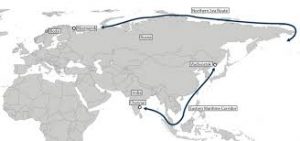
The Chennai-Vladivostok eastern maritime corridor has become operational and is carrying oil, food, and machines, Minister for Ports, Shipping, and Waterways said recently.
- The Chennai-Vladivostok Sea route, also known as the EMC, will link Russia’s east coast with South India.
- The EMC offers a significant reduction in both cargo transit time between India and the Russian Far East of up to 16 days and in distance by up to 40%, promising substantial efficiency gains in transportation.
- Currently, the route from Mumbai to St. Petersburg, Russia, via the Western Sea Route and Suez Canal spans 8,675 nautical miles or 16,066 km.
- At present, a large container ship from India takes around 40 days to reach Russia’s Far East region through Europe.
- In contrast, the distance from Chennai to Vladivostok via the EMC is significantly shorter, at only 5,647 nautical miles, or 10,458 km.
- This translates to substantial savings of 5,608 km in distance, providing significant reductions in logistical costs and enhancing the efficiency of cargo transportation between Russia, India, and Asia.
- En route, EMC passes through the Sea of Japan, the East China Sea, the South China Sea, the Malacca Straits, the Andaman Sea, and the Bay of Bengal.
- The route includes port options if needed, such as Dalian, Shanghai, Hong Kong, Ho Chi Minh City, Singapore, Kuala Lumpur, Bangkok, Dhaka, Colombo, and Chennai.
GSAT-N2 (GSAT-20):
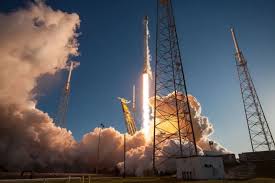
India’s GSAT-N2 (GSAT-20) communication satellite was successfully launched by SpaceX’s Falcon-9 rocket recently.
- GSAT-N2 (GSAT-20) is India’s advanced communication satellite.
- It was developed by New Space India Limited (NSIL), the commercial arm of ISRO under the Department of Space.
- It was launched onboard SpaceX’s Falcon-9 rocket into a geosynchronous transfer orbit.
- It is designed to provide data and internet services to remote regions and enable in-flight Internet connectivity across the Indian subcontinent.
- It will provide significant data transmission capacity, particularly for India’s Smart Cities Mission.
- It is a high-throughput communication satellite operating in the Ka-band.
- The satellite is equipped with multiple spot beams and is designed to support a large user base, utilizing small user terminals.
- GSAT-N2 features 32 user beams—8 narrow spot beams over the Northeast region and 24 wide spot beams covering the rest of India.
- These beams will be supported by hub stations across mainland India.
- The satellite’s Ka-band high-throughput communication payload provides a throughput of around 48 Gbps.
- The GSAT-N2 satellite, with a lift-off mass of 4,700 kg, has a mission life of 14 years.
- This is India’s highest throughput satellite and the only one exclusively operating in the highly sought-after Ka-band.
Regulatory Framework for Laboratory-Grown Meat:
The Food Safety and Standards Authority of India (FSSAI) is planning to put a regulatory framework for laboratory-grown meat, dairy, and egg products.FSSAI regulates plant-based protein products, but lab-grown and fermentation-derived proteins have no clear regulations.
India prepares to host the International Cooperative Alliance (ICA) Global Conference in November 2024:
As India prepares to host the International Cooperative Alliance (ICA) Global Conference in November 2024, organised by Indian Farmers Fertilizer Cooperative (IFFCO) with support from 18 ICA member organisations. The event aims to promote the cooperative movement, which includes over 800,000 societies across 29 sectors.
Dhudmaras Village:
Dhudmaras, a village in Chhattisgarh’s Bastar district, has been selected to participate in the Best Tourism Village Upgrade Programme (BTVUP) under the United Nations Tourism for Rural Development Programme (UNTRDP) by the UN World Tourism Organisation (UNWTO). This recognition marks its potential as a hub for eco-tourism and sustainable development.
Indian Equatorial Electrojet Model:
Scientists from the Indian Institute of Geomagnetism (IIG), Navi Mumbai have developed the Indian Equatorial Electrojet (IEEJ) Model to accurately predict the Equatorial Electrojet over the Indian sector. Ground-based magnetometers at Tirunelveli station, near India’s southern tip, are used for regular EEJ measurements.
Bharat National Cyber Security Exercise 2024:
The Bharat National Cyber Security Exercise (Bharat NCX 2024) was inaugurated to fortify India’s cybersecurity resilience.It is a 12-day exercise to prepare India’s cybersecurity professionals to tackle evolving threats with advanced cyber defence capabilities.
Grand Commander of the Order of the Niger (GCON) Award:
Nigeria conferred its 2nd-highest national award, the Grand Commander of the Order of the Niger (GCON), on India’s Prime Minister. India’s Prime Minister became the 2nd foreign dignitary to receive the distinction after Queen Elizabeth, who was conferred the award in 1969.
Tuna Export Hub in Andaman & Nicobar Islands:
The Fisheries Department plans to develop the Andaman and Nicobar (A&N) Islands as a tuna export hub.The global tuna market is worth USD 41.94 billion and the Indian Ocean is considered the second-largest tuna region, producing 21% of the world’s tuna.
As per Marine Products Export Development Authority, India’s tuna exports surged by 31.83% in 2023-24, (valued at USD 87.96 million).
World Toilet Day 2024:
World Toilet Day, observed annually (since 2013) on 19th November, is a United Nations initiative raising awareness about the global sanitation crisis and promoting safe, accessible toilets as part of Sustainable Development Goal 6: Ensuring water and sanitation for all by 2030. 2024 Theme: ‘Toilets-A Place for Peace’ which emphasises that billions of people face heightened threats to sanitation due to conflict, climate change, natural disasters, and systemic neglect.
India’s Neighbourhood Policy:
India’s neighbourhood policy is under scrutiny as its relations with several neighbouring countries face challenges. With a history of deep cultural and historical ties, India’s approach to its neighbours must balance its growing global aspirations with regional sensitivities.Neighbourhood First Policy: Emphasizes prioritizing relations with immediate neighbours,Seeks economic integration, development partnerships, and cultural ties.
High-Performance Buildings:
High-Performance Buildings (HPBs) are essential for achieving sustainable living in the face of climate change, rising urbanization, and energy demands. Designed to conserve resources, enhance energy efficiency, and withstand extreme weather, HPBs represent the future of sustainable construction and urban resilience. HPBs are designed to optimize energy efficiency, reduce resource consumption, and provide resilience against unpredictable climatic conditions.
World Anti-Doping Agency: To Host GLDF
India, in collaboration with the World Anti-Doping Agency (WADA), will host the Global Learning and Development Framework (GLDF) Results Management Training in New Delhi.Training aims to standardize anti-doping procedures, foster collaboration among nations, and strengthen the global sport integrity framework.This workshop is organised by the National Anti-Doping Agency (NADA) India in collaboration with WADA, with support from the Japan Sports Agency (JSA) and the Japan Anti-Doping
United Nations Relief and Works Agency for Palestine Refugees:
India has fulfilled its annual contribution of USD 5 million for the year 2024-25 to the United Nations Relief and Works Agency for Palestine Refugees in the Near East (UNRWA), with the release of the second tranche of USD 2.5 million.
African Penguin : Now Endangered
The African Penguin, or Cape Penguin, is now “Endangered” per the IUCN, with under 10,000 breeding pairs, mostly in South Africa. Conservationists warn of possible extinction in the wild by 2035.Scientific Name: Spheniscus demersus. Endemic Region: Southern Africa; primarily South Africa and Namibia.




